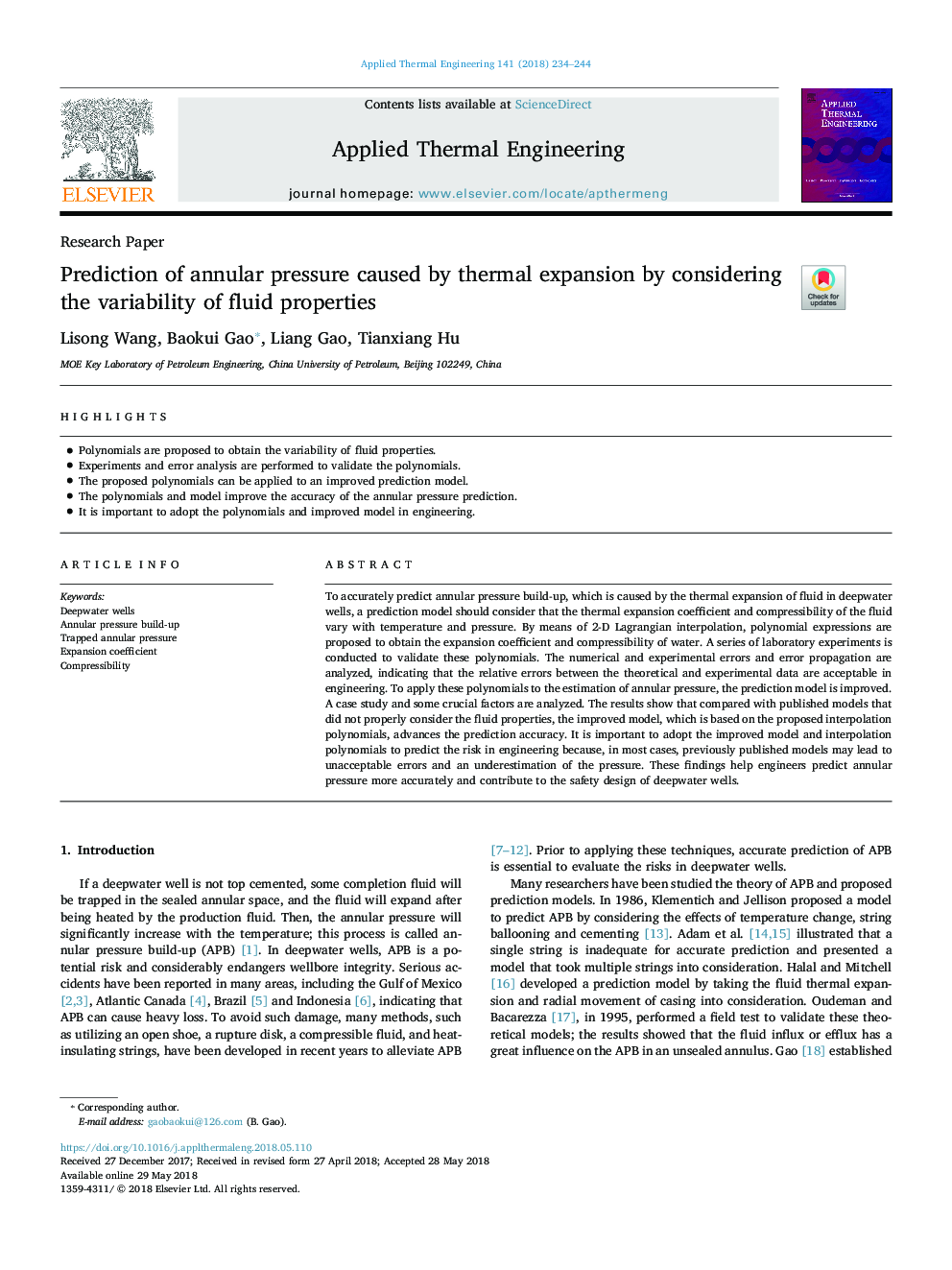| کد مقاله | کد نشریه | سال انتشار | مقاله انگلیسی | نسخه تمام متن |
|---|---|---|---|---|
| 7044922 | 1457088 | 2018 | 11 صفحه PDF | دانلود رایگان |
عنوان انگلیسی مقاله ISI
Prediction of annular pressure caused by thermal expansion by considering the variability of fluid properties
ترجمه فارسی عنوان
پیش بینی فشار حلقوی ناشی از انبساط حرارتی با توجه به تغییرات خواص مایع
دانلود مقاله + سفارش ترجمه
دانلود مقاله ISI انگلیسی
رایگان برای ایرانیان
کلمات کلیدی
چاه های عمیق آب، افزایش فشار ناگهانی، فشار حلقوی به دام افتاده، ضریب انبساط، فشرده سازی،
ترجمه چکیده
برای پیش بینی دقیق میزان افزایش حجم حلقوی، که بوسیله گسترش حرارتی در چاه های عمیق آب ایجاد می شود، یک مدل پیش بینی باید در نظر بگیرد که ضریب انبساط حرارتی و فشرده سازی مایع با دما و فشار متفاوت است. با استفاده از اینترپلال دوبعدی لاگرانژی، برای بیان ضرایب انبساط و فشردگی آب، اصطلاحات چندجملهای پیشنهاد می شود. یک مجموعه آزمایش های آزمایشگاهی برای اعتبارسنجی این چندجملهایها انجام شده است. خطاهای عددی و تجربی و انتشار خطا تجزیه و تحلیل می شوند که نشان می دهد که خطاهای نسبی بین داده های نظری و تجربی در مهندسی قابل قبول هستند. برای اعمال این چند جملهای به برآورد فشار حلقوی، مدل پیش بینی بهبود یافته است. یک مطالعه موردی و برخی از عوامل حیاتی تحلیل شده است. نتایج نشان می دهد که در مقایسه با مدل های منتشر شده که خواص سیال را به درستی در نظر نمی گیرند، مدل بهبود یافته، که بر اساس چندجمله ای درونیابی پیشنهاد شده است، دقت پیش بینی را افزایش می دهد. مهم است که مدل های پیشرفته و چندجملهای اینترپلات را برای پیش بینی خطرات مهندسی در نظر بگیریم، زیرا در اغلب موارد مدل های قبلا منتشر شده ممکن است به خطاهای غیر قابل قبول و کم توجهی به فشار منجر شوند. این یافته ها به مهندسان کمک می کند تا فشار حلقه را دقیق تر پیش بینی و به طراحی ایمنی چاه های عمیق آب کمک کند.
موضوعات مرتبط
مهندسی و علوم پایه
مهندسی شیمی
جریان سیال و فرایندهای انتقال
چکیده انگلیسی
To accurately predict annular pressure build-up, which is caused by the thermal expansion of fluid in deepwater wells, a prediction model should consider that the thermal expansion coefficient and compressibility of the fluid vary with temperature and pressure. By means of 2-D Lagrangian interpolation, polynomial expressions are proposed to obtain the expansion coefficient and compressibility of water. A series of laboratory experiments is conducted to validate these polynomials. The numerical and experimental errors and error propagation are analyzed, indicating that the relative errors between the theoretical and experimental data are acceptable in engineering. To apply these polynomials to the estimation of annular pressure, the prediction model is improved. A case study and some crucial factors are analyzed. The results show that compared with published models that did not properly consider the fluid properties, the improved model, which is based on the proposed interpolation polynomials, advances the prediction accuracy. It is important to adopt the improved model and interpolation polynomials to predict the risk in engineering because, in most cases, previously published models may lead to unacceptable errors and an underestimation of the pressure. These findings help engineers predict annular pressure more accurately and contribute to the safety design of deepwater wells.
ناشر
Database: Elsevier - ScienceDirect (ساینس دایرکت)
Journal: Applied Thermal Engineering - Volume 141, August 2018, Pages 234-244
Journal: Applied Thermal Engineering - Volume 141, August 2018, Pages 234-244
نویسندگان
Lisong Wang, Baokui Gao, Liang Gao, Tianxiang Hu,
